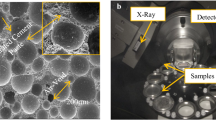Abstract
The present work aimed to explore the potential of using Al2(SO4)3 and NaHCO3 as gas-producing additives for the formation of foamed gypsum. Three systems of additives, namely Al2(SO4)3 + CaCO3, Al2(SO4)3 + citric acid, and NaHCO3, were investigated for their foam-forming ability in order to lower the thermal conductivity while preserving the compressive strength of the foamed gypsum. Emphasis was given to the setting time such that it would lie within 20–25 min, for the formulation to be practically useful. The results showed that, within the desired setting time, NaHCO3 provided the lowest thermal conductivity (~0.22 W/mK) and the highest efficiency (i.e., the highest rate of the thermal conductivity reduction for each percent of additives) among the three systems studied. It was also the system that best preserved the compressive strength for every unit reduction in the thermal conductivity. However, the corresponding compressive strength of 0.72 MPa was still very low, about three times lower than that of the other systems. The Al2(SO4)3 + CaCO3 system yielded a lower thermal conductivity (~0.24 W/mK) than the Al2(SO4)3 + citric system (~0.31 W/mK), although their corresponding compressive strengths (~2.4 MPa) were quite similar. Therefore, given the desired setting time, the Al2(SO4)3 + CaCO3 system produced the best combination of thermal conductivity and compressive strength.










Similar content being viewed by others
References
http://www.nesdb.go.th/portals/0/news/journal/eco_journal/04-10_2550/74.pdf. Accessed 15 April 2014
Skujans J, Vulans A, Iljins U, Aboltins A (2007) Measurements of heat transfer of multi-layered wall construction with foam gypsum. Appl Thermal Eng 27:1219–1224
Demir I, Serhat Baspinar M (2008) Effect of silica fume and expanded perlite addition on the technical properties of the fly ash-lime-gypsum mixture. Constr Build Mater 22:1299–1304
Serhat Baspinar M, Kahraman E (2011) Modifications in the properties of gypsum construction element via addition of expanded macroporous silica granules. Constr Build Mater 25:3327–3333
Gutierrez-Gonzalez S, Gadea J, Rodriguez A, Junco C, Calderon V (2012) Lightweight plaster materials with enhanced thermal properties made with polyurethane foam wastes. Constr Build Mater 28:653–658
Chindaprasert P, Boonserm K, Chairuangsri T, Vichit-Vadakan W, Eaimsin T, Sato T (2011) Plaster materials from waste calcium containing chemicals, organic fibers and inorganic additives. Constr Build Mater 25:3193–3203
Li G, Yu Y, Zhao Z, Li J, Li C (2003) Properties study of cotton stalk fiber/gypsum composite. Cem Concr Res 33:43–46
Zhang H, Xu Q, Zhao Z, Zhang J, Sun Y, Sun L, Xu F, Sawada Y (2012) Preparation and thermal performance of gypsum boards incorporated with microencapsulated phase change materials for thermal regulation. Sol Energy Mater Sol Cells 102:93–102
Su JF, Wang XY, Wang SB, Zhao YH, Huang Z (2012) Fabrication and properties of microencapsulated-paraffin/gypsum-matrix building materials for thermal energy storage. Energy Convers Manag 55:101–107
Colak A (2000) Density and strength characteristics of foamed gypsum. Cem Concr Compos 22:193–200
Vimmrova A, Keppert M, Svoboda L, Cerny R (2011) Lightweight gypsum composites: design strategies for multi-functionality. Cem Concr Compos 33:84–89
Rubio-Avalos JC, Manzano-Ramirez A, Yanez-Limon JM, Contreras-Garcia ME, Alonso-Guzman EM, Gonzalez-Hernandez J (2005) Development and characterization of an inorganic foam obtained by using sodium bicarbonate as a gas generator. Constr Build Mater 19:543–549
Kyri H, Brandle K, Muller M, Heine H (1977) Production of porous gypsum moldings. U.S. Patent 4040850
Bazelova Z, Pach L, Lokaj J (2010) The effect of surface active substance concentration on the properties of foamed and non-foamed gypsum. Ceramics 54(4):379–385
Arikan M, Sobolev K (2002) The optimization of a gypsum-based composite material. Cem Concr Res 32:1725–1728
Singh M, Garg M (1997) Retarding action of various chemicals on setting and hardening characteristics of gypsum plaster at different pH. Cem Concr Res 27(6):947–950
Badens E, Veesler S, Boistelle R (1999) Crystallization of gypsum from hemihydrate in presence of additives. J Cryst Growth 198(199):704–709
Magallanes-Rivera RX, Escalante-Garcia JI, Gorokhovsky A (2009) Hydration reactions and microstructural characteristics of hemihydrate with citric and malic acid. Constr Build Mater 23:1298–1305
Acknowledgments
This work is supported by the National Metal and Materials Technology Center, Thailand, under Grant no. P1200971.
Author information
Authors and Affiliations
Corresponding author
Rights and permissions
About this article
Cite this article
Umponpanarat, P., Wansom, S. Thermal conductivity and strength of foamed gypsum formulated using aluminum sulfate and sodium bicarbonate as gas-producing additives. Mater Struct 49, 1115–1126 (2016). https://doi.org/10.1617/s11527-015-0562-1
Received:
Accepted:
Published:
Issue Date:
DOI: https://doi.org/10.1617/s11527-015-0562-1




